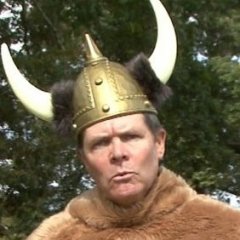Chainsaw Safety--Guaranteed!
With the recent high profile chainsaw accidents involving Greg Norman and Peter McCormick, it might be time for Mickey McCord to devote an entire training series to chainsaw safety. While we're waiting on Mickey, I'll reveal the Three Rules of Absolute Chainsaw Safety.
My entire GCS career was based on the chainsaw. The only golf courses that would hire me were the courses in trouble and they were in trouble because of trees--and bad business practices--but mostly trees. The previous superintendents, although skilled in turf science, usually lacked the ability to hornswoggle committees, owners and county commissioners into allowing for the removal of trees.
I had the knack for convincing folks to let me remove trees, usually by quoting the old master architects concerning trees making for bad golf. (I did this in what I thought was a passable Scottish accent, but probably sounded like the growling of a drunken hound dog.) The difficult part was getting permission for that first tree. After they saw sunlight hit the green for the first time, management would gleefully help me choose the next tree.
I took a lot of trees in my time, probably 20,000 or so. As I did most of the saw work myself, I have enough experience to offer advice to my brethren out there struggling with shaded greens, root-infested fairways and that hardpan that lives under the drip lines of big trees.
Chainsaw Safety Rule #1: Don't touch it.
If you don't touch it, it probably won't hurt you. The chainsaw is one of the most amazing tools in human history, but the damn thing is like a machine right out of a Steven King novel. It will kick back in your face, attack your arms, legs and feet, sling sawdust, splinters of buried nails, barb-wire and fire ants into your eyes . . . and that's all before you get tired and the chain grabs a vine while the engine is idling and the bar leaps toward your crotchetal regions.
I blame the chainsaw manufacturers for making it appear that Joe Homeowner should own one of these things. Surely if Joe DIY can run one, then grounds pros will have no trouble at all. Chainsaw makers used to put an "anti-kickback" device on homeowner chains, a little bar between the teeth. (We called it the "anti-cutting" device.) This little bar, while it reduced kickback, also taught the inexperienced operator bad habits like cutting with the nose of the bar.
When the operator progressed up to a pro chain, like a square tooth chisel chain mounted on a big, fast saw, the potential for a terrible kickback incident increased.
Forcibly inducted into the cult of the chainsaw at age 17, I learned to run a saw in the aftermath of the Great Atlanta Ice Storm of '73. With over 3000 frozen trees strewn across the fairways, I was handed a Homelite bow saw and promptly trapped a big pine inside the bow. Hey, it was '73, we didn't even wear seatbelts.
Starting in '76, I spent two years clearing the jungle rough of a muni and we had several saw accidents, except during the 6-month period after Leroy stole our chainsaws and we had to use axes. (We did have several axe accidents.) I eventually learned how to stop the accidents: Reduce the authorized operators to just me and Matt Jones.
Rule #1 is important because crazy things happen around chainsaws. I've seen hands nearly amputated, chains explode, flinging metal shrapnel after touching a hidden rock, and ankles broken when a spring-pole (limb bent under pressure) ripped loose. A close friend had his leg ripped off when a tree unexpectedly snapped as the saw released decades of stored energy.
A violent kickback broke a bone in my forearm. (That's why I never look down the line of the bar, always stay offset.) Another friend was flung through the air when a white oak he was de-weighting became a catapult. He landed on his stomach and the saw, still running, deep-tined his calf muscle.
A downed sweetgum snatched the saw out of my hands when the tree pinched and rolled over. It sent the saw, still running, end over end, until it crashed into my truck door.
Chainsaw Rule #2: If you must touch the saw, wear ALL the safety gear--and don't take it off until you are safe at home--and have had a shower.
I once dropped a massive pine twixt a green and a lightning shelter, a skillful drop. While doing the mandatory end zone dance, I stupidly removed my helmet, face screen and glasses. This allowed a large, dime-sized glob of floating pine sap to affix itself to my eyeball. The subsequent eyeball scraping in the eye doc's office still haunts me.
Finally, Rule #3, a simple principle I learned while filming a demolition class in the Army. The instructor asked, "What is the safest way to carry demo?"
The answer? "Let your buddy carry it."



1 Comment
Recommended Comments